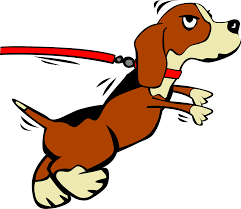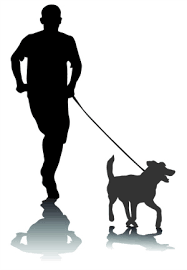
I have been asked a lot lately “What are some tips on how to get my dog to stop pulling while walking”. Usually it is followed by a comment like, “I have tried everything and nothing works...what type of collar should I be using”?
There is so much in these two statements. Iit is really hard to address the concerns properly since every dog is different. Their reasons for committing a particular behavior may vary as well . Without seeing the dynamics, knowing the dog and the owner and their methods of interaction, it is quite difficult for a trainer to put a finger on what exactly is occurring. However, I am going to attempt in this blog to ball park it for people and actually give some tips on how to accomplish a loose leash heel.
Before I get into that though, I want to discuss a few suggestions.
Read another blog I wrote last year called “Two Secrets to Dog Training”. I refer to it all of the time in one on ones. I find it really gets to the heart of proper communication between an owner and their dog. It addresses some thinking errors owners have and presents some ideas on how one should shape their training.
Discard the idea you have "tried everything and nothing works”. I guarantee you have not. Everything is an awful lot. I would suggest to you that you have tried one or two things, met with limited success and gave up. No dog is hopeless. Any dog can be taught to heel properly once you start communicating properly with them.
Abandon the concept that there are tricks which can be used. Like most things worth having, a good well trained dog requires dedication, time, commitment and work. There are no magic pills. This includes training collars. Training collars are just that...they are tools. They cannot and will not replace good solid proper communication. A training collar may HELP proper training but it will not be a replacement for the same.
Stop comparing your dog with your parent’s dog, the dog down the road or your previous dog. You have a different dog, you are a different person and you are different now than you were then. I have met some dogs that were easier to train in certain areas then others. It is completely normal.

Now that those concepts are out of the way, let's get down to some nitty gritty methods that can help you.
Tip A: Get your dog accustomed to the leash early.
Introduce the leash to your dog at a young age. This does not mean you have to hook your puppy onto the leash and drag him around. What I am suggested is that the dog should get used to a leash and get some practice coming when called. Use lots of rewards and praise for returning to your side when wandering around. If you do this, you will have a solid foundation for leash work.
Tip B: Walk your dog a lot
I cannot stress this enough. A walk around the block a couple of times a week is not going to cut it. Your dog is cooped up all day. If the only time he gets some freedom off your property is a couple of times a week for ten to fifteen minutes, you are defeating your dog before you even get started. Imagine yourself in the same scenario, cooped up in the house, allowed out in the backyard, but rarely off your property. Then you are expected to behave perfectly. Ummmm, not going to happen. A dog should be walked everyday, period. It is good for you and good for your dog. The walk should be a leashed walk. While off leash is ok if you live in an area and have a dog where this is appropriate, it cannot and will not replace a good on leash walk.

Tip C: Have realistic expectations
When out on a normal walk, do not expect a complete loose leash heel the entire time. The dog’s mind is going to wander. This is ok. I always take the stance that unless I am in class or a working situation where I want a heel that is totally textbook, I relax. As long as my dogs are not pulling me, I am ok with them being a little in front of me or a little behind me
Tip D: Socialize your dogs properly
Expose them to as much as you can. If they are regularly walked, they will be accustomed to encountering other people, dogs, squirrels, rabbits, and different smells. If this is something they are used to, they are less likely to yank you off your feet when they come across said distraction on your walk.
Tip E:
Begin in an area with low distraction and increase the difficulty as the dog’s proficiency with heeling improves. Think of it this way, your kid will follow you down a empty sidewalk no problem at all but put them in the middle of Disneyland and all bets are off. Start small with low distraction and build on success. While I am on this topic, remember you are setting your dog up for success. Start easy, bomb proof your dog on the easy things before you make it harder.
Tip F:
A good obedience class is worth it’s weight in gold. It will help tremendously in all aspects of your training. A good instructor can evaluate your techniques and communication. A good instructor can tweak what you are doing and demonstrate how to improve things. A good class will provide socialization. Your dog will be exposed to other dogs and people and you will have to practice around these distractions.

Here are a couple of techniques I have used with success
“Become a tree”. I describe this technique in depth in the blog I mentioned above. No need for me to go into it again. It works like a charm when done correctly.
“Run with your dog”. Attach the leash to yourself, the other end to your dog. Proceed to a playground and run. Go nuts. Run around the posts and obstacles changing directions as much as you can. Encourage your dog to follow you. make it a game. Pretty soon, the dog will realize staying by your side is a great thing, is a lot of fun and is needed. If you do not or cannot run, walk...just change directions a lot. The dog will be forced to follow and pay attention.
“Too bad so sad”. I like using this one when a dog is pulling to get to something. It is very similar to the “Become a tree” method I mention above but with a twist. Say that your dog really pulls in order to get to the car. Attach the leash to your dog, sit the dog and tell him he is going for a ride in the car. Start walking the dog toward the car. If the dog lunges ahead, turn around say “too bad, so sad”. Return to the starting point. Repeat. Soon, the dog will understand...if I pull, I return to the start. If I keep a loose leash, I get to the car. Substitute car for food, person, a favorite toy…Get the idea?
This list is not meant to be a “How to” document. More a list of suggestions that one should use to shape one's thinking.
As always, comments, questions and criticism is welcome